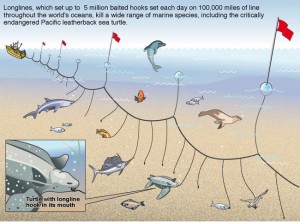- A fishery is the industry or occupation devoted to the catching, processing, or selling of fish, shellfish, or other aquatic animals.
- The Gulf of Mexico is home to some of the world’s most productive fisheries.
- The Gulf of Mexico accounts for approximately 1/5 of the total domestic fisheries landings (fish caught in the United States) each year. This number includes fish caught during commercial and sport fishing operations.
- Commercial fishing is the process of capturing fish for a profit. The revenue derived from commercial harvest in the Gulf of Mexico accounts for about 25% of the total commercial fishery revenue in the United States and is worth approximately $900 million each year.
- Shrimp, snapper, grouper, and stone crab are some of the Gulf’s most important commercial species.
- Sport fishing, which refers to fishing for the purpose of pleasure or competition, is a very important industry in Florida. In 2008, for example, 3.2 million recreational fishermen took a fishing trip in the Gulf of Mexico.
- Popular Gulf of Mexico sport fishing species include tarpon, redfish, grouper, tuna, mahi-mahi, marlin, and sharks.
- Gulf of Mexico fisheries are extremely economically valuable, sustaining thousands of fishermen and their families, and providing a way of life for coastal communities.
- The mangroves, salt marshes, and seagrass beds common throughout the Gulf of Mexico provide nursery habitat for a wide range of commercially valuable marine species.

Mangroves provide important nursery habitat for many commercially and recreationally fished species.
- The northern Gulf of Mexico serves as one of the world’s only two known spawning grounds for the very valuable and highly endangered Bluefin tuna.
- Overfishing is the practice of harvesting more fish than can be replaced via reproduction in a given time period. It is exhausting the Gulf of Mexico fisheries and threatening the balance of nearby ecosystems.
- For example, some grouper and snapper populations have declined by more than 50% since the 1950s.
- In recent years, the development of advanced, highly efficient fishing technologies has contributed to overfishing. We simply catch too many fish too quickly.
- Fishing methods such as trawling (pulling large nets behind powerful boats) and longlining (fishing with multiple hooks on a long fishing line, sometimes up to 50 miles long) further decimate marine populations becuase of the bycatch associated with these practices.
- Bycatch is a marine organism caught unintentionally by fishermen targeting alternate species. Bycatch threatens marine populations that are not targeted by commercial and recreational fisheries, because many of these incidentally caught animals do not survive, even when they are released.
- Often, marine mammals, birds, and sharks are trapped as bycatch.
- In order to protect the future of the Gulf of Mexico fishing industry, fisheries must be carefully managed. Scientists conduct research to set quotas, or limits, on the quantity of a particular species that may be harvested.
- Quotas help ensure that the fishing industry operates sustainably so that it does not destroy the fish populations over time.
- Sustainable fishing practices will allow us to continue catching and enjoying seafood in the future. It will also ensure that fishermen will have jobs for years to come.
- The establishment of Marine Protected Areas also may also help protect Gulf fisheries. MPAs are areas where human activity is regulated to protect natural resources, including fish. These areas provide a place for marine species to reproduce and grow, thereby helping to maintain steady populations.
- In order to be effective, fishing quotas and Marine Protected Areas must be carefully monitored and regulations must be enforced.
Practice Good Stewardship
- Download a sustainable seafood Pocket Guide from the Monterey Bay Aquarium website. Print it out and carry it in your wallet. When you go to restaurants, use your card to help you choose sustainable seafood options.
- If you go fishing, be sure to follow all state fishing regulations and guidelines. Never keep illegal fish!
Review Questions
- What is a fishery?
- What are some of the most common commercially fished species in the Gulf of Mexico?
- What is overfishing? What is one cause of overfishing in the Gulf of Mexico?
- What is sustainable fishing? Why is it important to choose sustainable seafood options when consuming seafood?
Glossary
Bycatch: Any marine organisms caught unintentionally by fishermen while intending catch other fish.
Commercial Fishing: Capturing fish and other seafood to earn a profit.
Domestic Landings: Fish caught in the United States.
Fishery: Is the industry or occupation devoted to the catching, processing, or selling of fish, shellfish, or other aquatic animals.
Longlining: The commercial fishing method of using a long line, called the main line, with many baited hooks attached; has a high rate of bycatch.
Mangrove: A coastal tree that is adapted to saltwater; provides important nursery habitat for many juvenile fish species.
Marine Protected Area (MPA): An area where natural resources are given greater protection than in the surrounding waters.
Overfishing: The practice of fishing a body of water to a degree that the supply of fish or shellfish is exhausted and the nearby ecological balance is upset; the removal of fish from the water faster than they can reproduce.
Quota: A limit on the amount of fish that can be caught.
Sport Fishing: Fishing for the purpose of pleasure or competition.
Sustainable: In a manner that will not have long term negative impacts on the environment or population of organisms.
Trawling: A method of fishing that involves pulling a large net through the water; has a high rate of bycatch.




